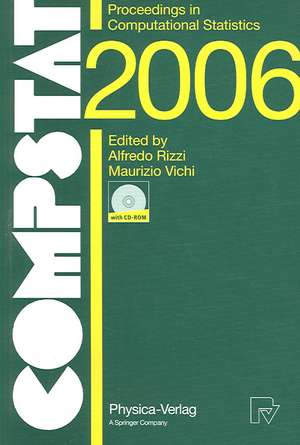COMPSTAT 2006 - Proceedings in Computational Statistics: 17th Symposium Held in Rome, Italy, 2006
Editat de Alfredo Rizzi, Maurizio Vichien Limba Engleză Mixed media product – 3 aug 2006
Preț: 957.13 lei
Preț vechi: 1167.23 lei
-18% Nou
Puncte Express: 1436
Preț estimativ în valută:
183.14€ • 191.73$ • 151.54£
183.14€ • 191.73$ • 151.54£
Carte tipărită la comandă
Livrare economică 07-21 aprilie
Preluare comenzi: 021 569.72.76
Specificații
ISBN-13: 9783790817089
ISBN-10: 3790817082
Ilustrații: XXV, 537 p. With CD-ROM.
Dimensiuni: 155 x 235 x 37 mm
Greutate: 0.78 kg
Ediția:2006
Editura: Physica-Verlag HD
Colecția Physica
Locul publicării:Heidelberg, Germany
ISBN-10: 3790817082
Ilustrații: XXV, 537 p. With CD-ROM.
Dimensiuni: 155 x 235 x 37 mm
Greutate: 0.78 kg
Ediția:2006
Editura: Physica-Verlag HD
Colecția Physica
Locul publicării:Heidelberg, Germany
Public țintă
ResearchCuprins
Classification and Clustering.- Issues of robustness and high dimensionality in cluster analysis.- Fuzzy K-medoids clustering models for fuzzy multivariate time trajectories.- Bootstrap methods for measuring classification uncertainty in latent class analysis.- A robust linear grouping algorithm.- Computing and using the deviance with classification trees.- Estimation procedures for the false discovery rate: a systematic comparison for microarray data.- A unifying model for biclustering.- Image Analysis and Signal Processing.- Non-rigid image registration using mutual information.- Musical audio analysis using sparse representations.- Robust correspondence recognition for computer vision.- Blind superresolution.- Analysis of Music Time Series.- Data Visualization.- Tying up the loose ends in simple, multiple, joint correspondence analysis.- 3 dimensional parallel coordinates plot and its use for variable selection.- Geospatial distribution of alcohol-related violence in Northern Virginia.- Visualization in comparative music research.- Exploratory modelling analysis: visualizing the value of variables.- Density estimation from streaming data using wavelets.- Multivariate Analysis.- Reducing conservatism of exact small-sample methods of inference for discrete data.- Symbolic data analysis: what is it?.- A dimensional reduction method for ordinal three-way contingency table.- Operator related to a data matrix: a survey.- Factor interval data analysis and its application.- Identifying excessively rounded or truncated data.- Statistical inference and data mining: false discoveries control.- Is ‘Which model . . .?’ the right question?.- Use of latent class regression models with a random intercept to remove the effects of the overall response rating level.- Discretefunctional data analysis.- Self organizing MAPS: understanding, measuring and reducing variability.- Parameterization and estimation of path models for categorical data.- Latent class model with two latent variables for analysis of count data.- Web Based Teaching.- Challenges concerning web data mining.- e-Learning statistics — a selective review.- Quality assurance of web based e-Learning for statistical education.- Algorithms.- Genetic algorithms for building double threshold generalized autoregressive conditional heteroscedastic models of time series.- Nonparametric evaluation of matching noise.- Subset selection algorithm based on mutual information.- Visiting near-optimal solutions using local search algorithms.- The convergence of optimization based GARCH estimators: theory and application.- The stochastics of threshold accepting: analysis of an application to the uniform design problem.- Robustness.- Robust classification with categorical variables.- Multiple group linear discriminant analysis: robustness and error rate.










